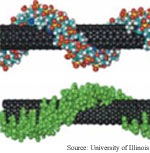|
NEWS
|

|
 |
DNA-nanotube
combo spots toxins
Medical diagnostics and biomedical research are
poised to benefit from nanosensors that combine DNA's
sensitivity to specific substances and nanotubes' electrical
and optical sensitivity to the environment
|
Self-improving
software
If people are expected to learn on the job, why
isn't software? Although some kinds of software are capable
of learning, it's more difficult to design software that
learns as it works without requiring a separate training
process...
|
Detector
boosts quantum crypto
Self-assembly
makes flexible LCD
Graphics
chips speed holograms
Nanorods
focus microscope |
FEATURES
|
View
from the High Ground: Cornell's Jon Kleinberg
Six degrees of separation, buying gasoline
by the molecule, the science of popularity, all just getting
along online, intellectual prosthetics, Big Science, making
up questions, and telling stories.
|
How
It Works: Quantum computing: qubits
Photons, electrons and atoms, oh my! These particles are
the raw materials for qubits, the basic building blocks
of quantum computers. |
|
 |
News RSS feed 
Blog RSS feed 
Bookshelf RSS feed

New: TRN's
Internet Services
TRN's Jobs Center
|
| |
SMALLEY'S
RESEARCH WATCH |
| February
3, 2006 |
Mega
fishfinder
Fish
populations are in decline, largely due to
overfishing. But getting accurate assessments
is challenging, which has made conservation
efforts all the more difficult. Traditional
sonar scans of fish populations are produced
by ships towing sonar gear, resulting in very
slow scan lines that produce spotty data
...
January
27, 2006
Green
growing
January
20, 2006
Pigs
in space
January
20, 2006
Warming
threatens sea life |
|
|
| |
"In
most areas of science and technology, the origins
of new breakthroughs can still be found in the work
of a small number of people -- or even a single
person -- working at their own pace on their own
questions, pursuing things that interest them. "
- Jon Kleinberg, Cornell University |
|
| |
|
| |
Thanks
to Kevin from
GoldBamboo.com
for technical support |
|

